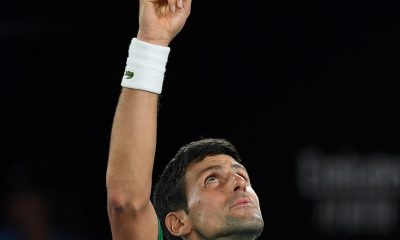All Sports
The Vintage Sportswear Boom: Uncovering its Exponential Growth

The Vintage Sportswear Boom: Uncovering its Exponential Growth
Is the future of fashion changing? Across the globe, vintage clothing has seen meteoric growth over the past decade. Reports have projected that the secondhand clothing market is projected to outpace the fast fashion market, with consumers shifting their buying habits. This global phenomenon is showing no signs of slowing down, with expectations of the vintage market set to grow 127% by 2026. This significant trajectory will see the global secondhand apparel market grow three times as fast as the global apparel market.
With vintage clothing firing on all cylinders, consumers continue to flock to the latest thrift or vintage store, as it now enters the mainstream. The average consumer is now beginning to see the widespread benefits of the secondhand clothing industry, in terms of the environmental and economic factors at the forefront. After all, this model plays an integral part in the circular economy.
As with fashion, certain trends and styles often come and go, as well as gain or lose growth in different areas of the globe. However, some trends have shown dominant progress globally, with no signs of stopping anytime soon.
Vintage sportswear has become a global phenomenon over the past few decades, leading the pack as one of the most popular categories fans of vintage flock towards. From Classic Football Shirts helping to lead the charge for vintage football jerseys into the mainstream in the UK, to popular culture continuing to reinvigorate the American vintage sportswear scene, every corner of the globe is seeing a continued interest in this area.
But why vintage sportswear specifically? What has consumers flocking to buy retro sportswear specifically time and again? In this article, we will delve into some of these reasons as well as forecast the future for this particular category of vintage.

Nostalgia for days now gone
In the world of sports and fashion, they both seem bound together by the notion of newness. Each new season comes with a fresh start and hope for the season ahead, also introducing multiple new jerseys for the fans to wear on game day. In the English football leagues, each team sees a minimum of three new kits introduced every year. However, despite the push for sales, it seems there is also space for the retro sportswear market.
Cult kits and nostalgia for the golden days of a club are closely linked with vintage sportswear. Some of the most sought-after vintage jerseys command monumental prices. For fans of football: think Netherlands 1988, Liverpool 89/90 and Germany 1990. For these kits, it is not just the aesthetics, but the nostalgia of the time. For all of the jerseys mentioned above, they represent a golden era for the team, whether it is winning the league or a European tournament.
The emotions tied to a fan’s favourite player or era can be highlighted by wearing a vintage jersey. Whether it is the first kit they ever wore or the first time they went to watch their team play, the memories of these times are very emotive and are usually best replicated through the jersey being worn.

The economics of vintage sportswear
The popularity of vintage jerseys has also seen prices exponentially rise across the board. Running parallel to other growing markets, such as trainers or streetwear, the resell economy of vintage sportswear is booming. After all, money flows where attention grows.
Along with trainers or streetwear, vintage sportswear has amassed a collectable culture. Some sports enthusiasts may seek out every jersey from their favourite sports team, whereas others may have a grail list of their ten favourite aesthetic jerseys from around the world. These trends have lent into the “collect them all” culture, which brings with it supply and demand surges. To hunt down your favourite football jersey could take a lot of time, money and effort, which all adds to the thrill of collecting. For a sports fan, finding their “holy grail” may take a lifetime and even adds to the excitement of it all.
For the reasons above, it makes sense why vintage sportswear has followed the same course as trainers and streetwear. The stark rise in popularity of specialist collectors only brings with it a price rise.

The stamp of approval from celebrities
Another reason for the growth of vintage sportswear is its wider adopted fanbase, in other areas of popular culture. In recent times, some of the most famous celebrities have been spotted in modern or vintage sports jerseys, which only adds to the attention of people outside of the sports realm. By musicians or models wearing these jerseys, the humble sports jersey crosses realms into the world of fashion.
To take an example, the likes of Drake and Kendall Jenner have notably worn football jerseys over the years, from Juventus, PSG and Barcelona, to name a few. With Instagram and Pinterest being visual-based platforms, celebrities and influencers can make or break a trend through their reach to the mass market. With Drake and Kendall Jenner amassing over 440 million followers on Instagram alone, it makes sense the influence celebrities can bring to particular subsets, in this instance football jerseys. Through their influence on popular culture, they can play a notable part in seeing a trend move in one direction or another.

Colliding with the world of fashion
In the world of fashion, sports jerseys have also been closely linked with some of the biggest sporting brands, whilst also tiptoeing on the periphery of their high-end or luxury counterparts. Football jerseys have long been intertwined with leading sports brands such as Nike, Adidas, Reebok and Puma, who are the leading sports jersey suppliers. Last season, 21 different brands supplied jerseys for the 98 European teams in the top five leagues in Europe.
Meanwhile in the USA, being the official supplier for a sport is big business. Nike committed $1 billion over an 8-year period in 2017-18 to be the official supplier for the NBA. Again for the NFL, Nike signed a similar deal to serve as the league’s official uniform supplier. With some of the biggest sports brands in the world acting as kit suppliers, it acts as a promotion for the brand as well as the football club.
In the wider sphere of fashion, from luxury to streetwear, we have seen a rise in the popularity of sportswear with brands and styling. In the world of streetwear, football clubs have welcomed notable collaborations from brands such as Palace, Jordan and Humanrace. In the 2023/24 season, we have even seen Los Angeles streetwear brand ‘Undefeated’ become the main sponsor for Birmingham City FC in the Championship. For fans of streetwear, seeing their favourite brands collaborate or even sponsor a sports team, can begin the journey of their love for sportswear and in turn vintage sportswear.
In the upper echelons of the fashion world, we have even seen some nods to the world of sportswear. Spanish fashion house Balenciaga has seen multiple collections feature sportswear-inspired collections, including football jerseys that retail for up to £1,000. Some other notable brands to follow the football jersey trend include Virgil Abloh’s Off-White and leading fashion house Louis Vuitton.
In reference to aesthetics and trends, a recent wave to take centre stage is the football-inspired “blokecore”, which shows a resemblance to the much older “casuals” movement. In the UK itself, this resurgence has been long seen on the turnstiles, with Stone Island, CP Company and Burberry at the forefront of the wave.
With the wide acceptance of sportswear in the world of fashion and culture, it only makes sense that the rise of vintage sportswear has also seen a boom. With more mouths brought to the table, comes a wider adoption and increased growth in the space.

Popular Culture reinvigorating the market
In the world of film and television, any piece of media that reaches the mass market can send a product or trend into a frenzy. In the world of sports, this is certainly no different.
A good example of this came recently in 2020 during the ESPN mini-series “The Last Dance” which chronicled the rise of Michael Jordan and the 1990s Chicago Bulls. This series exploded Jordan and the Chicago Bulls back into the public eye, with “Michael Jordan” being searched 821 times a minute on eBay the day the documentary was released. In addition to this, one-day sales for Chicago Bulls items skyrocketed 5,156% over the month before the documentary release. The same trend was likely to have happened for the recent 2023 David Beckham series. The list can go on and on.
These figures can support the importance popular culture can play in setting a trend alight. It also acknowledges the consumer and profit culture in which we live today, with people notably looking to make some money during these booms.
Of course, these trends often settle down after a while. However, as film and television continue to pump out content, it increases the likelihood of sportswear, memorabilia and vintage items heading in an upward trajectory.

Sustainability is here to stay?
In the world of vintage and second-hand clothing, sustainability is one of the leading reasons for its rise in popularity. With vintage sportswear, the same principles come into play.
With people generally becoming more aware of the impact that fast fashion and throwaway culture have on the environment, it has seen their heads beginning to turn on these once widely accepted practices.
Of course, there still remain outliers in the industry, with the Chinese behemoth Shein seemingly accepting its role as the brand that can push more product lines faster than anyone. It will be interesting to see whether these brands can stay perched at the top of their ivory towers when the chickens come home to roost, with growing pressure on them to move away from these unethical practices in a world of finite resources. Or whether they can pivot with the times and remodel to stay relevant and at the top.
This “pivot” has been seen most recently by British fast fashion empire Primark, as well as Urban Outfitters in the past, who have introduced vintage clothing concessions into their stores. It seems that most savvy consumers can largely see through this shallow tactic on their behalf, as the notion of Primark selling vintage clothing is one laughable contradiction to its business model.
However, through these companies introducing vintage into their stores, it shows acknowledgement on their part that consumers may begin to shift away from fast fashion, albeit on a slow-turning ship for many. It seems to be part of this eco-conscious future, many of these brands will need to accept vintage is here to stay, and that they will need to join this movement if they want to remain on top.
With sustainability playing an increasingly important role in the world of fashion, it seems only obvious that vintage clothing, and in turn retro sportswear, will continue to boom.

What does the future hold for vintage clothing and vintage sportswear?
As consumer habits shift and swing towards sustainable alternatives, vintage clothing and retro sportswear will only be set for growth. Many forecasters predict the vintage wave only to go up and on a global scale.
A few questions remain. If the vintage sporting space continues to boom, will supply be squeezed and demand reach its head? As vintage goods cannot be reproduced, their numbers remain in somewhat limited quantities, so if demand vastly outweighs supply, prices would skyrocket and inevitably price out many consumers from the market. This of course would eventually lead to a cool down and correction of pricing. However, if stock levels remain comfortable within this level of growth, we can expect the boom to continue, without the worry of a bust.
For vintage clothing, on the whole, its predictions are very boisterous and yet also seem simple facts, not mere speculation. On the surface, it seems the only way is up for this industry, however with the fast fashion industry expected not to give up its fight easily, expect many twists and turns over the next few decades. Mass market fakes and counterfeits will also be expected to play their part in disrupting the industry. With big players set to join the party, can vintage remain affordable and trendy? Time will tell.
On the whole, it is fair to expect vintage clothing and the sportswear subset to continue to transform the world of fashion. Vintage is likely to fill the gap between the past and present, helping to shape the way we express ourselves through clothing. With mass adoption from leading brands such as Nike and Adidas, who can help to set an example, they can act as a bridge between the two worlds to help encourage sustainability and a circular economy. This of course requires a conscience over profit. Which will win? It is too close to call.

We hope you enjoyed the article “The Vintage Sportswear Boom: Uncovering its Exponential Growth.” What are your predictions for this trend? Let us know!
Read more on sports below:
- What is the fastest tennis serve of all time?
- The fastest rugby player ever
- Who are the best penalty takers of all time?
-

 Football4 months ago
Football4 months agoThe Best Penalty Takers of All Time
-

 News6 months ago
News6 months agoThe Best Male Tennis Players of All Time
-

 News4 months ago
News4 months agoThe Fastest Rugby Players Ever
-

 Uncategorised7 months ago
Uncategorised7 months agoWhat Dinosaur Has 500 Teeth?
-

 Football6 months ago
Football6 months ago10 of the most underrated footballers in the world right now
-

 Football4 months ago
Football4 months agoPlayers with the most goals in a Premier League season
-

 Football4 months ago
Football4 months agoWho is the Fastest Football Player in the World?
-

 News6 months ago
News6 months agoJoe Solecki: Fighters At A Glance








